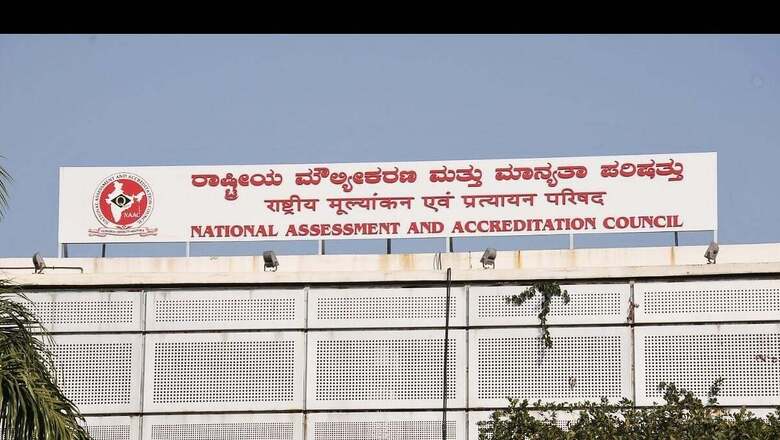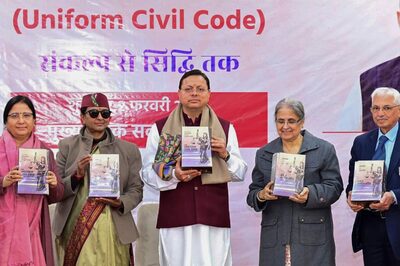
views
Tweaks in software, modifications in the way data is collected and validated, and penal action on institutions giving out false data are among the key changes likely to be introduced in the procedure followed by the National Assessment and Accreditation Council (NAAC) for assessing and ranking colleges and universities across the country after it ran into allegations of ‘irregularities’ in its functioning.
These are among the major recommendations likely to be made by the committee set up by the Centre to review lapses and suggest long-term measures in streamlining the procedure of data collection and verification followed by NAAC for assessing higher education institutions (HEIs), News18 has learnt.
The committee set up last November is led by former Indian Space Research Organisation (ISRO) chief K Radhakrishnan and has officials and experts from various agencies and institutions, including University Grants Commission (UGC), All India Council for Technical Education (AICTE), Indian Institute of Technology (IITs), National Institute of Technology (NITs), representatives from state governments and universities, educators and computers science engineers, among others.
The committee is expected to come out with its report by mid-June while it has already had several rounds of deliberations last month, including one headed by Union education minister Dharmendra Pradhan, News18 has learnt.
“All the data collection mechanisms are likely to change, which will be done through tweaks in software or IT systems used to collect and verify information sought from colleges/universities for their assessment and ranking. Data science and crowdsourcing could be used for the same. The idea is to reduce non-verifiable data as much as possible,” said an official in the know.
The aim, the official added, is to get a single set of authentic data for which data integration is an important step. At present, various agencies and regulatory bodies in the higher education sector ask colleges/universities to give out the institution’s data such as courses offered, number of students enrolled, faculty members etc multiple times in a year for various projects or assessments. The task is then given to different individuals and, for lack of understanding at some level, gaps in data collated start occurring.
“For those still found giving incorrect information, the committee is likely to suggest penal action against them to act as a deterrent,” the official said.
Also, a second official privy to the matter said looking at all data, only what is relevant and verifiable should be used for rankings so that there is no scope of mismatch, gaps or any duplicity.
“For data integration, API (application programming interface – a software that allows two applications/systems to talk to each other and exchange information) will be used to link all the sites that require the same set of information that’s common to their use. It will help exchange data without any hassle and if any additional or separate information is required, institutions can fill that up separately. They will need to submit fresh data only once a year except for anything required additionally or exclusively,” the second official said.
For instance, if UGC has stored a common set of information about a particular college and if the same information is required by AICTE also, it will automatically exchange that database through API and the said institution will not have to be bothered for the same.
“Only those authorised to get the data will get access to it, the software will ensure that. So when you have data integrity established through all platforms and uniqueness is there then the head of the institution can also evaluate it better, as it has to be done only once. This will help generate authentic data, based on which further evaluation will be done,” the second official said.
The committee is also tasked to identify what data should be common to all regulatory bodies, which shall be posted at one place.
What was the controversy?
The alleged irregularities were flagged by an internal review panel of the council, which was set up by its former executive chairperson Bhushan Patwardhan last September. Patwardhan resigned from his post on March 5 this year over the UGC “ignoring” the findings of the said report, which flagged “malpractices, compromised IT systems, allocating assessors arbitrarily, vested interests and allowing access of internal systems to ex-staff, among others”.
What is NAAC?
NAAC is an autonomous body under the UGC that grades higher education institutions in India. It is a multi-layered process through which NAAC does a quality check of the institutions on various crucial parameters, including curriculum, faculty, research and infrastructure, among others.
The first step towards assessment is that institutions signing up for accreditation submit a self-study report (SSR) based on qualitative and quantitative metrics, which are then verified and validated by various experts’ teams of the accrediting body. This is followed by physical visits to the institutions by peer review teams (PRTs).
Why do NAAC rankings matter?
NAAC ranking are important for HEIs for various reasons with recognition as the top gain. Besides, a good ranking helps them attract capital, as funding agencies rely on these rankings before investing in them. More importantly, rankings help students going abroad for higher studies, as most global higher education institutions insist on recognised colleges/universities as part of admission criteria. Also, for student placements, hiring firms go by an institution’s overall national ranking before they set foot on campus.
Read all the Latest Education News here




















Comments
0 comment